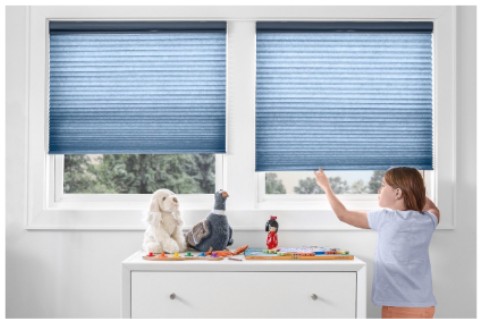Childproofing your home is an essential part of responsible parenting. While you may be diligent about childproofing cabinets, electrical outlets, and staircases, one area that is often overlooked is window treatments, particularly blinds. Window blinds are a common and practical feature in our homes. They offer control over light and privacy, adding aesthetic value to our living spaces. However, it’s important to recognize that blinds, if not chosen and handled with care, can present serious safety hazards to our little ones. In this comprehensive guide, we’ll delve into the critical aspect of childproofing related to windows and blinds. We’ll explore the potential risks and dangers associated with traditional blinds that utilize cords and strings, and we’ll provide you with a detailed overview of the child-safe blind options available in the market. When it comes to window blinds child safety, it’s essential to consider cordless or motorized options that eliminate the risks associated with cords and strings.
I. Understanding the Dangers
Before we delve into the solutions for child-safe blinds and installation techniques, it is crucial to grasp the potential dangers that traditional blinds can pose, especially when it comes to children’s safety. These hazards are primarily associated with the cords and strings used to operate blinds and can lead to serious accidents if not addressed properly.
Strangulation:
Strangulation is, without a doubt, the most severe risk associated with traditional blinds. The cords and strings used to raise and lower blinds can become perilous nooses for children. If not kept out of reach or properly secured, a child can accidentally become entangled in these cords, leading to life-threatening situations.
Choking Hazard:
Another often overlooked risk associated with traditional blinds is the presence of small plastic or metal components. These components are part of the blind’s mechanism and can detach, posing a significant choking hazard to children. These small parts may not only be enticing to explore for a curious child but can also become lodged in a child’s throat if accidentally ingested.
Climbing Hazards:
Children are naturally curious and inclined to explore their surroundings. When it comes to windows with blinds, they may be tempted to climb on window sills, furniture, or any nearby objects to reach the blinds. This behavior poses the risk of falling, potentially resulting in injuries.
II. Child-Safe Blind Options
These child-safe blind options eliminate the risks associated with traditional blinds that use cords and strings, reducing the potential hazards significantly. Let’s take a closer look at some of the most popular child-safe blind choices:
Cordless Blinds:
Cordless blinds, as the name suggests, eliminate cords and strings that pose a significant risk to children. They are operated by simply pushing or pulling the bottom rail to raise or lower them. Cordless blinds, as the name suggests, represent a practical and ingenious solution for making your windows safe for children. These blinds eliminate the cords and strings that can pose serious risks.
Motorized Blinds:
Motorized blinds are a convenient and safe option. This convenience not only guarantees child safety but also adds a touch of sophistication to your home decor. With motorized blinds, you have the power to control your window coverings effortlessly, which is a boon for busy parents.
Roller Shades:
Roller shades are a popular and chic alternative to traditional blinds. Roller shades are a cordless option that provides a sleek and modern look. Roller blinds child safety is a top priority for parents, making cordless roller shades a popular choice to ensure a secure environment for their children.
Cord Cleats:
If you prefer traditional blinds, cord cleats can be installed to keep cords out of a child’s reach. Make sure to wrap cords around the cleats and secure them. To ensure safety, you can neatly wrap the cords around the cleats and secure them. This simple yet practical safety measure ensures that cords remain organized and, most importantly, out of your child’s reach. Cord cleats offer a cost-effective way to improve the safety of traditional blinds without the need for a complete replacement.
Breakaway Tassels:
Some blinds come with breakaway tassels that are designed to disconnect when a certain amount of force is applied, reducing the risk of strangulation. In case a child becomes entangled, the tassels release, minimizing the risk of serious harm. Breakaway tassels are a thoughtful safety feature to consider when choosing blinds for your home.
III. Installation Tips for Child-Safe Blinds
Childproof blinds are a must in homes with little ones, and selecting child-safe window coverings is a proactive step in reducing potential hazards. Selecting child-safe blinds is only the first step in ensuring your child’s safety. Proper installation is equally important. Here are some installation tips to consider:
Measure Accurately:
Measure your windows accurately to ensure a perfect fit for your blinds. Follow the manufacturer’s guidelines for precise measurements.
Consult a Professional:
If you’re unsure about installation, consider hiring a professional to ensure the blinds are correctly installed and pose no safety risks.
Keep Cords Out of Reach:
Even with cordless or child-safe blinds, ensure that cords or strings are completely out of your child’s reach. Use cord cleats or wall anchors to secure cords neatly.
Regular Inspections:
Periodically check your blinds for any loose or damaged components. Replace any parts that may present a hazard.
IV. Additional Childproofing Window Safety
Child-safe window blinds offer peace of mind to parents, knowing that their children are protected from the dangers of traditional corded blinds. In addition to choosing child-safe blinds and installing them correctly, there are additional safety measures you can take to protect your child around windows:
Measure Accurately:
Measure your windows accurately to ensure a perfect fit for your blinds. Follow the manufacturer’s guidelines for precise measurements. You can also order made-to-measure child-safe blinds or cord and chain-free blinds from custom made blinds uk.
Window Guards:
Window guards are sturdy barriers that can be installed on windows to prevent children from falling out while still allowing fresh air to flow in.
Window Stops:
Window stops limit how far a window can be opened, preventing a child from accidentally pushing it wide open.
Furniture Placement:
Ensure that furniture is placed away from windows to prevent children from climbing and accessing blinds or windows.
Supervision:
While these safety measures are important, nothing beats the vigilance of supervising your child around windows. Keep a watchful eye on your child when they’re in a room with windows.
Conclusion
Beyond the blinds themselves, window safety can be further enhanced by considering the use of window guards and stops. Window guards are robust barriers that prevent children from falling out while allowing fresh air to circulate. Window stops, on the other hand, limit how far a window can be opened, reducing the risk of a child accidentally pushing it wide open. These measures add an extra layer of security to your childproofing efforts. Proper placement of furniture in your home is another vital element in ensuring window safety. By keeping furniture away from windows, you can discourage children from climbing and accessing blinds or windows, reducing the likelihood of accidents. In conclusion, it’s the combination of these safety measures – choosing child-safe blinds, vigilant supervision, proper cord management, window guards and stops, and smart furniture placement – that creates a secure environment for your little ones. With this comprehensive approach to childproofing, you can rest assured that your home is a safe and nurturing place for your children to thrive.


 Home
Home









